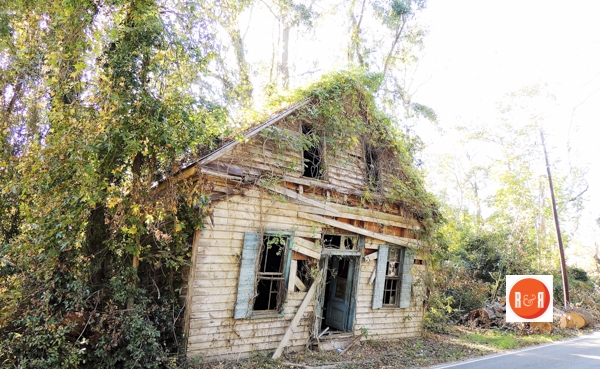When Roots and Recall began, those of us involved posted many of our own family connections. Though I knew little of my Buice family history, tons of data has been uncovered and shared in the past few years, it is rather remarkable! Relations from different sections of the country, individuals who had allied materials, and the descendants of sharecroppers all have contributed to preserve their piece of the farmstead’s story. As one individual, whose family lived on the farm wrote, “though the Buices owned the farm, my family also called it home…. “.

One of our favorite images having been contributed to R&R.com. What is in your shoe box?
But an important aspect of rural Southern life, rarely explored or discussed; is that of the business relationship between owner – tenant, or owner – sharecropper, or owner – laborers. A major source of data on the subject, came from the Hardin Family Collection in Chester County, S.C., journals that explore payments for services, hours, and dozens of names associated with their farm operations. Though the entire “extensive” journals are not posted for exploration, R&R does have them digitized and is happy to assist researchers. The names of those individuals listed, across the journals pages, are however searchable on line.
Another excellent picture of this rural farm relationship, is that of the Cooper Farm Collection of images and information, from Laurens County and most recently, with the donation of a store ledger, ca. 1912 from Fairfield County, even more information on labor contracts has been revealed. Maintaining a low cost agricultural labor force was indeed very important to the farmers, something which shows across the pages of these documents.
1) The Hardin Sharecropper Account Collection: This group consists of three account ledgers via Chester, S.C., listing dozens of names of sharecroppers and tenants who worked for the Hardin family in the late 19th century. A vast majority of the individuals listed on these pages are African American and having their names and residences, are vital links in uncovering local genealogy. The ledgers show what individuals purchased and what they were paid. Explore @: Sharecropping
2) The Cooper Farm Collection: A remarkable digital display of images showing the relationship between workers on the farm and the owners. Few collections offer such a remarkable glimpse into mid-20th century rural farm life. The Cooper family clearly admired and appreciated their employees. Explore @: Rural Life
3) The Kirkpatrick Store Collection: Surprisingly, at the back of the Kirkpatrick’s Store Leger, contracts for farm help were recorded in ca. 1912-14 for individuals working as laborers on the Kirkpatrick’s Fairfield County farm. These simply pages outline that for payment of only a few dollars monthly, and some meals, employees were under strict contract to work as outlined by their employer – as directed. Explore @: Farm Labor
Without question, these three collections outline different ways in which to explore the lives and complicated relationships, between “white” farm owners and their “African American” labor forces. Remarkably each shows a clear dependency on the other party, but unfortunately reveals little about the true nature of their daily dealings. The period between 1880-1940 is often discussed as one of the most racist in American history. Yet, the Cooper Farm collection shows nothing but friendship, pride and admiration for their one another. And the Kirkpatrick’s had their family portrait taken with two or more of their African American farm workers. This was not unusual during the period but was this an expression of appreciation or simply boasting, of their economic and social superiority, who knows? The image is indeed clearly reminiscent of antebellum images of master and slave.
What is most important, is that these records preserve the names, dates and locations of African Americans who are often overlooked as part of the economic and social fabric of rural society in post-Civil War history. So, it is gratifying that several descendants of these persons, have acknowledged, their appreciation to the website for having recorded just a little bit more about their ancestors, on the pages of Roots and Recall. So, thanks for your continuous support and efforts to share and preserve local history. You may also wish to read the following articles by Louise Pettus and other writers, concerning African American contributions and history in the post-Civil War period. Suggested reading: Isom Caleb Clinton of Lancaster and or Henry Toole of Rock Hill, S.C., for stories of remarkable kindness, friendship, and achievement during a period of unparalleled hardship and social transformation. Ms. Pettus’s collection of over 1,200 beautifully researched and written articles are being posted to R&R.com. Most of her research materials are deposited at the WU Pettus Archives Collection. Just about two hundred additional articles are yet to be posted across the pages of R&R.com.
R&R NOTE: The feature article on Cape Romain Lighthouses and the preservation work of Tommy Graham, by Zack Liollio, is another excellent presentation of work being performed to save S.C.’s building and heritage. Each of our volunteer writers enjoys the opportunity to visit and photograph interesting people and places. So, please let R&R know what is going on in your own community and who might deserve a little recognition for their preservation work? We would also like to also say thanks, to one of R&R.com’s earliest and biggest supporters, Mr. John Withers of Connecticut. He would like to see far more contributions of family stories and detailed records involving westward movement from the Carolinas. We too would like to encourage these stories of westward movement.
Have you checked the Southern Queries forum to see if you can help answer questions for members, it would be appreciated!
